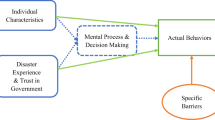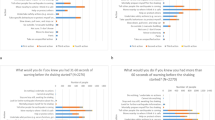Abstract
In the 'who, what, when, where and how' approach to disaster and contingency planning, the 'who' component often receives less attention than it should. It is relatively easy to determine the appropriate amounts of feed and bedding to store for emergencies or how to stage a replacement generator for electricity, whereas planning for the people who will respond to the emergency is more difficult. Understanding the issues involving 'who' designs and implements the contingency plan for disaster response can help facility managers to build a more effective plan, ultimately ensuring faster recovery and long-term success.
This is a preview of subscription content, access via your institution
Access options
Subscribe to this journal
We are sorry, but there is no personal subscription option available for your country.
Buy this article
- Purchase on Springer Link
- Instant access to full article PDF
Prices may be subject to local taxes which are calculated during checkout
Similar content being viewed by others
References
David, F.R. Concepts of Strategic Management 6th edn. (Prentice Hall, Upper Saddle River, NJ, 1997).
USDA APHIS. Final Rule: Handling of Animals; Contingency Plans. Federal Register 77, 76815–76824 (31 December 2012).
29 CFR Part 825. The Family and Medical Leave Act of 1993.
Kales, S.N., Tsismenakis, A.J., Zhang, C. & Soteriades, E.S. Blood pressure in firefighters, police officers, and other emergency responders. Am. J. Hypertens. 22, 11–20 (2009).
Goodwin, B.S. & Donaho, J.C. Tropical storm and hurricane recovery and preparedness strategies. ILAR J. 51, 104–119 (2010).
FEMA. National Response Framework 2nd edn. (Department of Homeland Security, Washington, DC, 2013). http://www.fema.gov/media-library-data/20130726-1914-25045-1246/final_national_response_framework_20130501.pdf.
Dupepe, L. Laboratory Animal Facilities: What Responders Need to Know. Integrated Training Summit, Nashville, TN, 21–25 May 2012. http://www.integratedtrainingsummit.org/presentations/2006/372.pps.
Hanlon, P. Bombing first responders: seeking counseling more “normative”. New England Psychologist (1 June 2013). http://www.nepsy.com/articles/leading-stories/bombing-first-responders-seeking-counseling-more-normative/.
Hughbank, R.J. & Cano, M. The role of counseling in an emergency response recovery plan. (The American Academy of Experts in Traumatic Stress, 2012). http://www.aaets.org/article171.htm.
Mitchell, J.T. & Everly, G.S. Critical Incident Stress Debriefing: An Operations Manual for CISD, Defusing and Other Group Crisis Intervention Services 3rd edn. (Chevron Publishing Corp, Columbia, MD, 2001).
Author information
Authors and Affiliations
Corresponding author
Ethics declarations
Competing interests
The author declares no competing financial interests.
Rights and permissions
About this article
Cite this article
Donaho, J. Building the human component into contingency plans. Lab Anim 43, 27–32 (2014). https://doi.org/10.1038/laban.423
Received:
Accepted:
Published:
Issue Date:
DOI: https://doi.org/10.1038/laban.423



